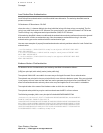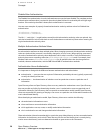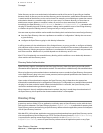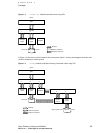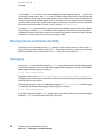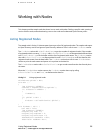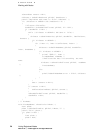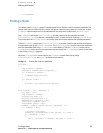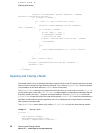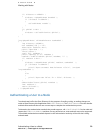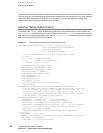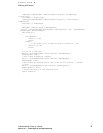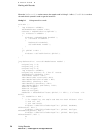} // PrintNodeName
Finding a Node
The sample code in Listing 2-2 (page 27) demonstrates how to find the node for a specific pathname. The
sample code opens an Open Directory session and gets an Open Directory reference. Then it calls its own
FindNodes routine and passes to it the pathname for the node that is to be found (/NetInfo/root).
The FindNodes routine calls dsBuildFromPath to build a data list for the pathname and calls
dsDataBufferAllocate to allocate a data buffer in which to store the result of calling dsFindDirNodes.
The routine then calls dsFindDirNodes to find the node whose name matches the specified pathname.
Then the FindNodes routine calls dsDataListAllocate to allocate a data list and provides that data list
as a parameter when it calls dsGetDirNodeName. The dsGetDirNodeName function copies the node name
from the data buffer filled in by dsFindDirNodes to the data list. Then the FindNodes routine calls its
PrintNodeName routine to print the node name that was found. The PrintNodeName routine is described
in the section Listing 2-1 (page 25).
When the PrintNodeName routine returns, the FindNodes routine cleans up by calling
dsDataListDeallocate and free() to deallocate the data list.
Listing 2-2 Finding the node for a pathname
void main ( )
{
long dirStatus = eDSNoErr;
dirStatus = dsOpenDirService( &gDirRef );
if ( dirStatus == eDSNoErr )
{
FindNodes("/NetInfo/root");
}
if ( gDirRef != NULL )
{
dirStatus = dsCloseDirService( gDirRef );
}
}
void FindNodes ( char* inNodePath ){
bool done = false;
long dirStatus = eDSNoErr;
unsigned long index = 0;
unsigned long bufferCount = 0;
tDataBufferPtr dataBuffer = NULL;
tDataListPtr nodeName = NULL;
tContextData context = NULL;
nodeName = dsBuildFromPath( gDirRef, inNodePath, "/");
if ( nodeName != NULL )
{
//Allocate a 32k buffer.
dataBuffer = dsDataBufferAllocate( gDirRef, 32 * 1024 );
if ( dataBuffer != NULL )
{
while ( (dirStatus == eDSNoErr) && (done == false) )
{
Finding a Node 27
2007-01-08 | © 2007 Apple Inc. All Rights Reserved.
CHAPTER 2
Working with Nodes



